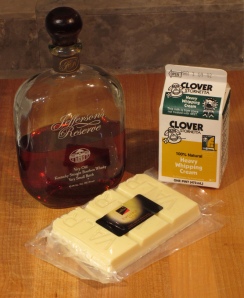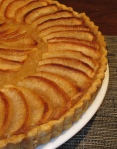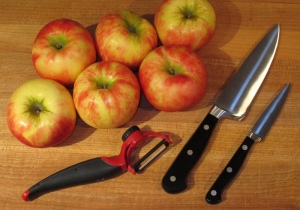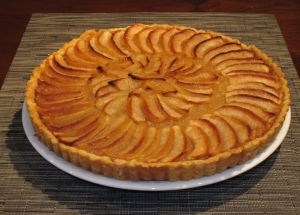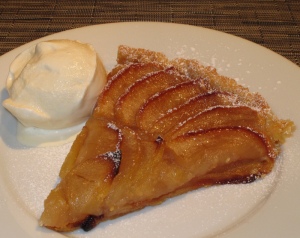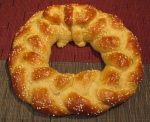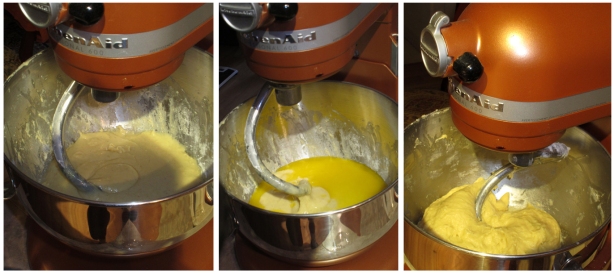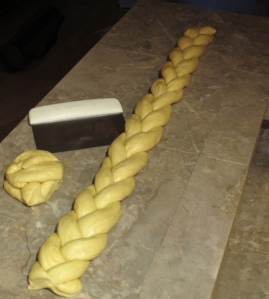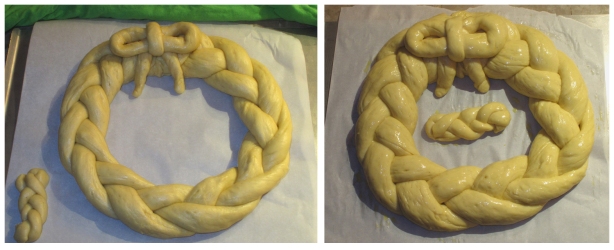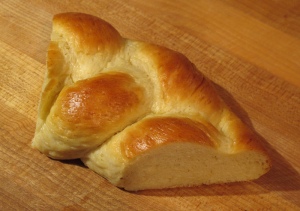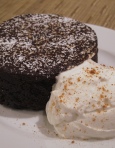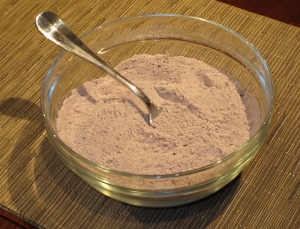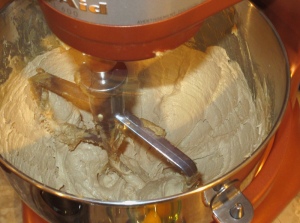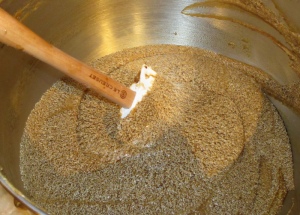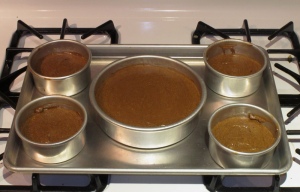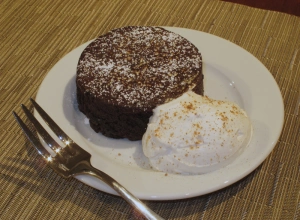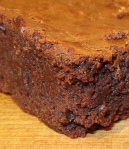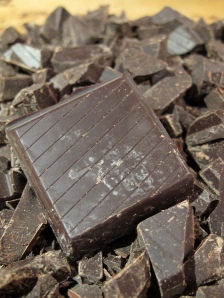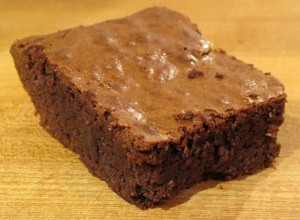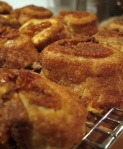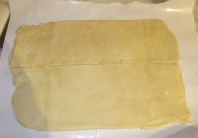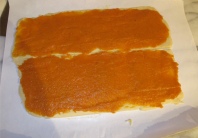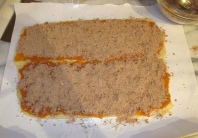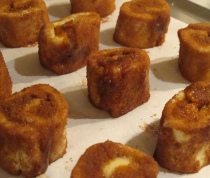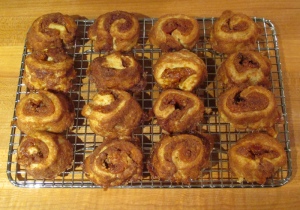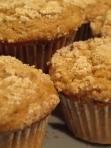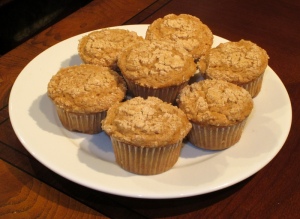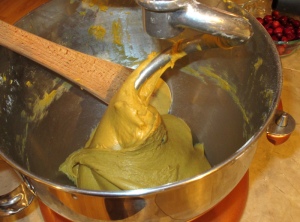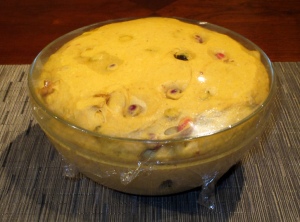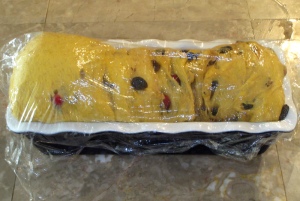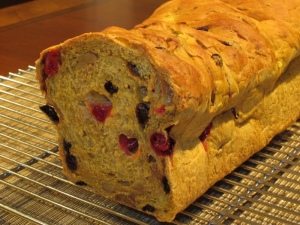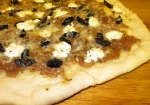 For the first recipe of 2013, the bakers of Tuesdays With Dorie are tackling Pizza with Onion Confit courtesy of Steve Sullivan, founder of the Acme Bread Company of Berkeley, California. Like many in the Bay Area culinary scene, Steve can trace his roots to a small restaurant occupying a converted Arts and Crafts home on Shattuck Ave. While working at Chez Panisse as a busboy in the late 70s, Steve became the first in-house bread baker; his stint coincided with the opening of the Cafe at Chez Panisse, which features a wood burning oven and pizzas unlike what had been seen in this country before. This Pizza and its accompanying Onion Confit reflect that style of pizza, often absent a red sauce, and featuring ingredients and flavors associated more with the Mediterranean and the South of France than Italy proper.
For the first recipe of 2013, the bakers of Tuesdays With Dorie are tackling Pizza with Onion Confit courtesy of Steve Sullivan, founder of the Acme Bread Company of Berkeley, California. Like many in the Bay Area culinary scene, Steve can trace his roots to a small restaurant occupying a converted Arts and Crafts home on Shattuck Ave. While working at Chez Panisse as a busboy in the late 70s, Steve became the first in-house bread baker; his stint coincided with the opening of the Cafe at Chez Panisse, which features a wood burning oven and pizzas unlike what had been seen in this country before. This Pizza and its accompanying Onion Confit reflect that style of pizza, often absent a red sauce, and featuring ingredients and flavors associated more with the Mediterranean and the South of France than Italy proper.
I’ve owned Baking With Julia for close to fifteen years. Prior to joining Tuesdays With Dorie, I had baked no more than a handful of the recipes. But one recipe that I make regularly is Steve Sullivan’s recipe for pizza dough. While I haven’t literally made a ton of this dough, I expect at some point to reach that milestone. Through all those pizzas, I had yet to make the one simple pie described in this recipe. This week would finally be that time.
At this point, I would normally direct recipe hounds to the blog of a fellow baker wherein the recipe might be found. This week, I’m hosting, so the recipe is found at the end of this post. The efforts of other TWD bakers can be found here.
Most times that I make this pizza dough, I use Caputo ‘OO’ flour, a finely milled flour (‘OO refers to the grind) imported from Italy. For the last several years, I’ve also substituted as much as a cup of Extra Fancy Durum flour, which adds a yellowish tint to the dough and seems to lend a bit of extra chew to the finished crust. This week I changed things up yet again to experiment with a higher gluten flour and longer fermentation times, in an attempt as Peter Rheinhart writes in The Bread Baker’s Apprentice, “to coax flavor from the grain.”
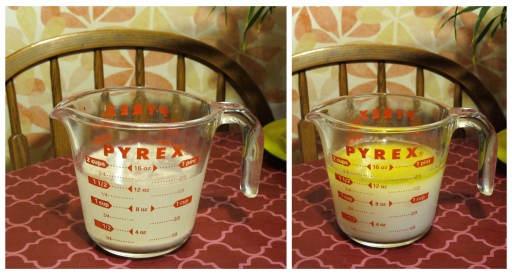 This recipe starts like most bread doughs with hydrating and proofing yeast in tepid water. After five minutes or so, a bit of bubbling and the smell of fermentation confirms your yeast is active. A few tablespoons of olive oil lend elasticity to the dough, especially important when using a higher protein flour.
This recipe starts like most bread doughs with hydrating and proofing yeast in tepid water. After five minutes or so, a bit of bubbling and the smell of fermentation confirms your yeast is active. A few tablespoons of olive oil lend elasticity to the dough, especially important when using a higher protein flour.
At this point, about half the flour is added to build a sponge, or pre-ferment, the purpose of which is to build flavor in the final dough. As the flour sits with water, a number of complex chemical reactions take place, the most visible of which is the yeast converting sugars to alcohol and carbon dioxide gas. Slower reactions involve enzymes which convert some of the starches to sugars and other flavor compounds. The recipe calls for the sponge to rise an hour and a half at warm room temperature. My sponge had an additional overnight cold ferment in the refrigerator. Colder temperatures reduce the yeast’s activity, while giving enzymes the time to catch up.
 Left to Right: Immediately after mixing; following 90 minutes room temperature fermentation; overnight cold ferment
Left to Right: Immediately after mixing; following 90 minutes room temperature fermentation; overnight cold ferment
 In the morning, I combined the sponge with additional flour and salt in the mixer and kneaded it into a finished dough. With the high-gluten flour, I noticed I had a much stiffer dough than I’m used to, even with only the minimum 2 cups of added flour. I wanted to give the dough a few turns by hand, but it was so much stiffer that I had to rely on the stand mixer for all of the kneading. I then shoved the dough in the refrigerator for about four hours, allowing it a final two hour rise at room temperature prior to shaping and baking.
In the morning, I combined the sponge with additional flour and salt in the mixer and kneaded it into a finished dough. With the high-gluten flour, I noticed I had a much stiffer dough than I’m used to, even with only the minimum 2 cups of added flour. I wanted to give the dough a few turns by hand, but it was so much stiffer that I had to rely on the stand mixer for all of the kneading. I then shoved the dough in the refrigerator for about four hours, allowing it a final two hour rise at room temperature prior to shaping and baking.
 With the dough finished it was on to the confit. My default onion is white, and after slicing two and a half pounds of yellow onions for the confit, I’m convinced they bring forth more tears. Shallots do likewise, though their improved flavor makes them worth the tears. As I was cooking in my parent’s kitchen, I did not have a large, wide, heavy bottomed pot in which to slowly cook the onions. I’m sure this had something to do with the onions taking much longer than stated. It was probably 20 minutes before I added the wine, which itself took almost 90 minutes to reduce.
With the dough finished it was on to the confit. My default onion is white, and after slicing two and a half pounds of yellow onions for the confit, I’m convinced they bring forth more tears. Shallots do likewise, though their improved flavor makes them worth the tears. As I was cooking in my parent’s kitchen, I did not have a large, wide, heavy bottomed pot in which to slowly cook the onions. I’m sure this had something to do with the onions taking much longer than stated. It was probably 20 minutes before I added the wine, which itself took almost 90 minutes to reduce.
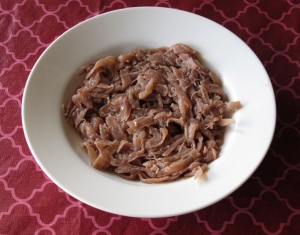 After two hours, I ended up with about three cups of onion confit, stained pink from the Pinot Noir. Prior to adding the wine, vinegar, and thyme sprigs, my onions hadn’t really begun to carmelize. With a wider skillet, I’m sure the result would improve, however I’ve had the best luck carmelizing onions in an enameled Dutch oven, starting on the stove and slowly finishing in the oven over the course of about two hours. The confit would definitely benefit from this treatment.
After two hours, I ended up with about three cups of onion confit, stained pink from the Pinot Noir. Prior to adding the wine, vinegar, and thyme sprigs, my onions hadn’t really begun to carmelize. With a wider skillet, I’m sure the result would improve, however I’ve had the best luck carmelizing onions in an enameled Dutch oven, starting on the stove and slowly finishing in the oven over the course of about two hours. The confit would definitely benefit from this treatment.
 With the primary ingredients ready, it was now time to assembly the remaining ingredients and finish the pizza. More important than type of flour or choice of toppings, the first order of business was to preheat the oven and baking stone. Having baked pizza in electric and gas ovens, on baking stones thin and thick, I’ve come to the conclusion that the thickest stone in the hottest oven possible is the key to a great pizza. After pre-heating the oven to 500o F with the stone in place, I give the stone an addtional 20-30 minutes of oven time at full temperature. The initial searing of moist dough on a hot stone really sets the crust, as well as causing trapped gases in the dough to expand, helping to produce a thin and crispy bottom crust.
With the primary ingredients ready, it was now time to assembly the remaining ingredients and finish the pizza. More important than type of flour or choice of toppings, the first order of business was to preheat the oven and baking stone. Having baked pizza in electric and gas ovens, on baking stones thin and thick, I’ve come to the conclusion that the thickest stone in the hottest oven possible is the key to a great pizza. After pre-heating the oven to 500o F with the stone in place, I give the stone an addtional 20-30 minutes of oven time at full temperature. The initial searing of moist dough on a hot stone really sets the crust, as well as causing trapped gases in the dough to expand, helping to produce a thin and crispy bottom crust.
For toppings, I kept with the Provencal theme, adding clumps of soft chevre, quartered oil-and-salt-cured black olives, and a sprinkling of Herbs de Provence. Above and below the confit I added some Fontina Val d’Osta, without which the other toppings might not have stayed put.
 Working without a peel, it took a bit of effort to get the pizza onto the stone. I’ve had more than one pizza fail to transfer over the years. On one occasion, I managed a version of the classic parlor trick in which the table cloth is removed, leaving the place settings intact. Only in my case the dough stayed on the peel, while all the topping ended up on a hot stone.
Working without a peel, it took a bit of effort to get the pizza onto the stone. I’ve had more than one pizza fail to transfer over the years. On one occasion, I managed a version of the classic parlor trick in which the table cloth is removed, leaving the place settings intact. Only in my case the dough stayed on the peel, while all the topping ended up on a hot stone.
After observing a Costa Mesa pizzeria, I made it part of my normal practice to build a pizza with only sauce and a bit of hard grating cheese on the peel, transferring that onto the stone for a short bake of two to three minutes. Removing the par-baked crust onto the peel, I then proceed with the remaining toppings before returning the pizza to the oven to finish baking. When working with a thin crust or a slack dough (often the case when using Caputo or a similarly non-bread strength flour), this two part process helps immensely.
I’ve also used parchment paper to top and transfer the pizza. At the high temperatures necessary for a crisp crust, parchment paper will burn around the edges, though not ignite. This can be avoided by pulling the parchment after 2 or 3 minutes in the oven.
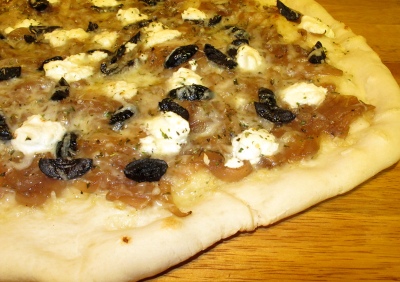 The finished pizza was decent, though not up to par with the best I’ve made. Had I ended up with a wetter dough as per my normal routine, that crust would have been better. The onion confit also could have been better… a wider pan, more carmelization on the onions. However before I make the confit again, I’ll make many more pizzas with my preferred onion technique: thinly sliced white onions, salted and allowed to sit for about 15 minutes before squeezing excess moisture with a towel.
The finished pizza was decent, though not up to par with the best I’ve made. Had I ended up with a wetter dough as per my normal routine, that crust would have been better. The onion confit also could have been better… a wider pan, more carmelization on the onions. However before I make the confit again, I’ll make many more pizzas with my preferred onion technique: thinly sliced white onions, salted and allowed to sit for about 15 minutes before squeezing excess moisture with a towel.
Pizza with Onion Confit
Makes 2 large pizzas. Here’s a dough that has enough texture and flavor to hold its own under any topping you choose, whether it’s the classic tomato and cheese or this Provencal-inspired onion confit. Opt for the confit and you might want to make it as soon as you set the sponge aside to rise, since it needs to cook for about an hour and then cool. Of course, you can prepare it a couple of days ahead and store it in the refrigerator until needed.
If you’re planning to make the Mixed-Starter Bread (page 113), save a piece of this fully risen dough to serve as the “old dough” in the first of the starters.
THE SPONGE
1 1/2 teaspoons active dry yeast
1 1/2 cups tepid water (about 80o F)
2 tablespoons olive oil
2 1/4 cups unbleached all-purpose flour
Place the yeast in a medium bowl (you can use the bowl from your mixer) and add the water, stirring to dissolve the yeast. Allow the yeast to rest for about 5 minutes, until it turns creamy. Stir the oil into the mixture and then gradually stir in the flour, mixing until well incorporated.
First Rise. Scrape down the sides of the bowl, cover, and let the sponge rest in a warm place (about 85o F) for about 1 1/2 hours, or until the sponge is very bubbly and has risen to about double its volume.
While the sponge is rising, make the onion confit.
THE CONFIT
3 tablespoons unsalted butter
4 medium onions (about 2 1/2 pounds total), peeled, halved, and sliced 1/8 to 1/4 inch thick
Salt and freshly ground black pepper to taste
1 tablespoon sugar
Fresh thyme sprigs or leaves to taste
1 1/4 to 1 1/2 cups red wine
1/4 cup red wine vinegar
Creme de cassis to taste (optional)
Melt the butter in a large heavy skillet and stir in the onions. Season with salt and pepper, stir, cover the pan, and cook the onions over low heat until they are soft, about 5 minutes. Sprinkle the sugar over the onions, stir, cover, and cook for another 5 minutes.
Add the thyme, 1 1/4 cups red wine, the vinegar, and a tablespoon or two of the creme de cassis, if you want to use it. Stir well and cook the mixture over the lowest possible heat, stirring from time to time, for about 1 hour, until just about all the liquid has evaporated. If the liquid has cooked off in half an hour or less, add a bit more wine. Turn the onions out onto a flat plate and let them cool to room temperature.
The onions can be made up to 2 days ahead and kept covered in the refrigerator. They should be brought to room temperature before they’re spread on the pizza.
THE DOUGH
The sponge(above)
2 to 2 1/4 cups unbleached all-purpose flour
2 to 3 teaspoons salt (depending on your taste)
If you didn’t make the sponge in your mixer bowl, transfer it to that bowl now. Use a rubber spatula to deflate the sponge, which will be sticky and loose, and fit the mixer with the dough hook. Add 2 cups of flour and the salt to the sponge and mix on low speed for 2 to 3 minutes. Increase the mixer speed to medium and, if the dough isn’t coming together nicely and cleaning the sides of the bowl, sprinkle in a little more flour by spoonfuls. Continue to knead on medium speed for another 4 to 5 minutes, until the dough is smooth and elastic. Although the dough may remain moist and a little sticky, you should be able to grip it without having it stick uncomfortably to your fingers.
Second Rise Place the dough in a lightly oiled large bowl, turn the ball of dough over so that its entire surface is moistened with oil, cover, and allow to rest in a warm place (about 85o F) for 1 1/2 hours, or until it has doubled in bulk and holds an impression for a few seconds when you prod it gently with your finger.
TO FINISH THE PIZZA
The onion confit (above) with olives, goat cheese, and/or Parmesan cheese(optional) — or any other topping you desire
Position a rack in the lower third of the oven, fit the rack with a baking stone or quarry tiles, leaving a border of at least 1 inch free all around and preheat the oven to 475o F. Rub a baker’s peel with cornmeal and set aside until needed.
Shaping the Dough Turn the dough out onto a lightly floured work surface (snip off a small piece of dough to save for the Mixed-Starter Bread if you want) and divide it into two pieces. You’ll probably have to bake the pizzas one at a time, so keep one piece covered while you work with the other. If you do not want to make two pizzas at this time, wrap one piece of dough tightly in plastic and store it in the refrigerator, where it will keep for a day or two, or wrap it airtight and freeze for up to a month. Thaw frozen dough, still wrapped, overnight in the refrigerator. Bring the chilled dough to cool room temperature before shaping. Shape the dough into a ball and then flatten it into a disk. To form the pizza, you can either turn and stretch the dough, stopping to allow the dough to rest for a few minutes if it springs back readily, or roll it out with a rolling pin. Either way, work the dough until it is about 1/4 inch thick (you can make it a little thinner if you prefer) and transfer it to the peel.
Topping and Baking Top with half the cooled onion confit and any or all of the optional ingredients, or the topping of your choice, leaving a 1-inch border around the rim of the pizza, and slide the pizza into the oven. Bake for 13 to 15 minutes, or until the topping is bubbling and the uncovered rim is puffed and beautifully golden. Repeat with the remaining dough and topping.
Storing Pizza is at its prime piping hot from the oven — don’t even think about reheating it.
Contributing Baker STEVE SULLIVAN
My notes:
For a more manageable thin crust pizzas, I increase the dough by 50%, dividing the result into four portions.
Extra fancy durum flour (finely milled Semolina) makes an excellent substitution for some of the flour in the dough.
Contrary to Steve’s admonition, not only do I think about reheating this pizza, I actually follow through. It’s best reheated on a hot stone, and failing that in a good toaster oven, wrapped in foil for the majority of the time. A microwave is not an acceptable substitute.
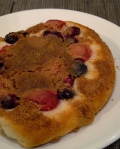 The Sweet Berry Fougasse marks my first Tuesdays With Dorie post in almost six months. While I continue to bake many of the recipes, in March I started a new job in San Francisco. Eleven hours away from home each day, much of that spent in front of computer monitor sapped my motivation to put together posts. Going forward, my hope is to return to a more regular schedule of baking and writing. However, this will be my first experiment with somewhat more abbreviated (for me anyway) posts.
The Sweet Berry Fougasse marks my first Tuesdays With Dorie post in almost six months. While I continue to bake many of the recipes, in March I started a new job in San Francisco. Eleven hours away from home each day, much of that spent in front of computer monitor sapped my motivation to put together posts. Going forward, my hope is to return to a more regular schedule of baking and writing. However, this will be my first experiment with somewhat more abbreviated (for me anyway) posts. After stretching out the dough (no rolling so as to preserve bubbles in the dough), I cut it into 6 pieces, toppings each with the fruit and then the sugar/flour/butter/spice mixture. A little over 20 minutes in a hot and steamy oven, and they were done, save a brief period to cool off.
After stretching out the dough (no rolling so as to preserve bubbles in the dough), I cut it into 6 pieces, toppings each with the fruit and then the sugar/flour/butter/spice mixture. A little over 20 minutes in a hot and steamy oven, and they were done, save a brief period to cool off.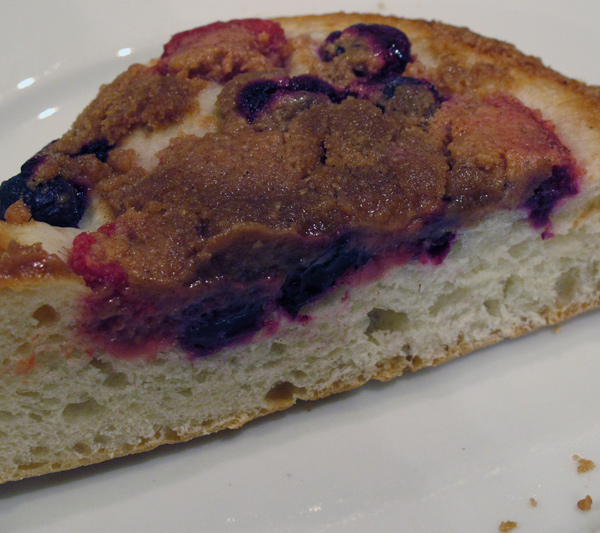 I prefer my pastries somewhat sweeter, both in the crust/crumb portion, as well as any fruit topping. Raspberries in particular bake up quite tart. I expected the streusel to counter the tart berries; it did not. Perhaps tossing fruit with sugar would help, though I don’t see myself baking this recipe again. I would definitely make the focaccia dough again for a savory application; the dough came together nicely and develops good texture with little work.
I prefer my pastries somewhat sweeter, both in the crust/crumb portion, as well as any fruit topping. Raspberries in particular bake up quite tart. I expected the streusel to counter the tart berries; it did not. Perhaps tossing fruit with sugar would help, though I don’t see myself baking this recipe again. I would definitely make the focaccia dough again for a savory application; the dough came together nicely and develops good texture with little work.

